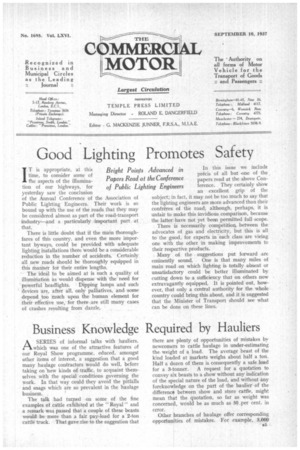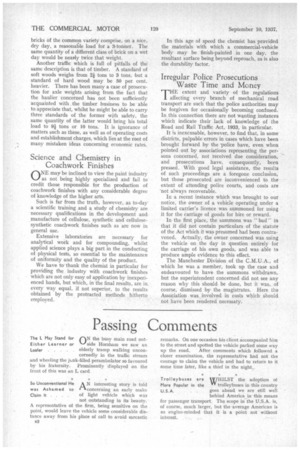Business Knowledge Required by Hauliers
Page 35

Page 36

If you've noticed an error in this article please click here to report it so we can fix it.
ASERIES of informal talks with hauliers, which was one of the attractive features of our Royal Show programme, educed, amongst other items of interest, a suggestion that a good many haulage contractors would do well, before taking on 'hew kinds of traffic, to acquaint themselves with the special conditions governing the work. In that way could they avoid the pitfalls and snags which are so prevalent in the haulage business.
The talk had tuTed on some of the fine examples of cattle exhibited at the " Royal " and a remark was passed that a couple of these beasts would be more than a fair pay-load for a 2-ton cattle truck. That gave rise to the suggestion that there are plenty of opportunities of mistakes by newcomers to cattle haulage in under-estimating the weight of a load. The average beast of the kind loaded at markets weighs about half a ton. Half a dozen of them is consequently a safe load for a 3-tonner. A request for a quotation to convey six beasts to a show without any indication of the special nature of the load, and without any foreknowledge on the part of the haulier of the difference between show and store cattle, might mean that the quotation, so far as weight was concerned, would be as much as 50 per cent. in error.
Other branches of haulage offer corresponding opportunities of mistakes. For example, 3,000 bricks of the common variety comprise, on a nice, dry day, a reasonable load for a 3-tonner. The same quantity of a different class of brick on a wet day would be neaPly twice that weight.
Another traffic which is full of pitfalls of the' same description is that of timber. A standard of soft woods weighs from 2i tons to 3 tons, but a standard of hard wood may be 50 per cent. heavier. There has been many a case of prosecution for axle weights arising from the fact that the haulier concerned has not been sufficiently acquainted with . the timber business to be able to appreciate that, whilst he might be able to carry three standards of the former with safety, the same quantity of the latter would bring his total load to 9i tons or 10 tons. It is ignorance of matters such as these, as well as of operating costs and establishment charges, which lies at the root of many mistaken ideas concerning economic rates.
Science and Chemistry in Coachwork Finishes
ONE may be inclined to view the paint industry as not being highly specialized and fail to credit those responsible for the production of coachwork finishes with any considerable degree of knowledge of the higher arts.
Such is far from the truth, however, as to-day' a scientific training and a study of chemistry are necessary qualifications in the development and manufacture of cellulose, synthetic and cellulosesynthetic coachwork finishes such as are now in general use.
Extensive laboratories are necessary for analytical work and for compounding, whilst applied science plays a big part in the conducting of physical tests, so essential to the maintenance of uniformity and the quality of the product. We have to thank the chemist in particular for providing the industry with coachwork finishes which are not only easy of application by inexperienced hands, but which, in the final results, are in every way equal, if not superior, to the results obtained by the protracted methods hitherto employed. In this age of speed the chemist has provided the materials with which a commercial-vehicle body may be finish-painted in one day, the resultant surface being beyond reproach, as is also the durability factor.
Irregular Police Prosecutions Waste Time and Money
TAE extent and variety of the regulations affecting every branch of mechanical road transport are such that the police authorities may be forgiven for occasionally becoming confused. In this connection there are not wanting instances which indicate their lack of knowledge of the Road and Rail Traffic Act, 1933, in particular.
It is inexcusable, however, to find that, in some districts, palpable errors in cases which have been brought forward by the -police have, even when pointed out by associations representing the persons concerned, not received due consideration, and prosecutions have, consequently, been pressed. With good legal assistance, the results of such proceedings are a foregone conclusion, but those prosecuted are inconvenienced to the extent of attending police courts, and costs are not always recoverable.
In a recent instance which was brought to our notice, the owner of a vehicle operating under a limited carrier's licence was summoned for using it for the carriage of goods for hire or reward.
In the first place, the summons was " bad " in that it did not contain particulars of the statute of the Act which it was presumed had been contravened. Actually, the owner concerned was using the vehicle on the day in question entirely for the carriage of his own goods, and was able to produce ample evidence to this effect.
The Manchester Division of the C.M.U.A., of which he was a member, took up the case and endeavoured to have the summons withdrawn, but the superintendent concerned did not see any reason why this should be done, but it was, of course, dismissed by the magistrates. Here the Association was involved in costs which should not have been rendered necessary.




























































































